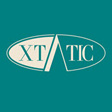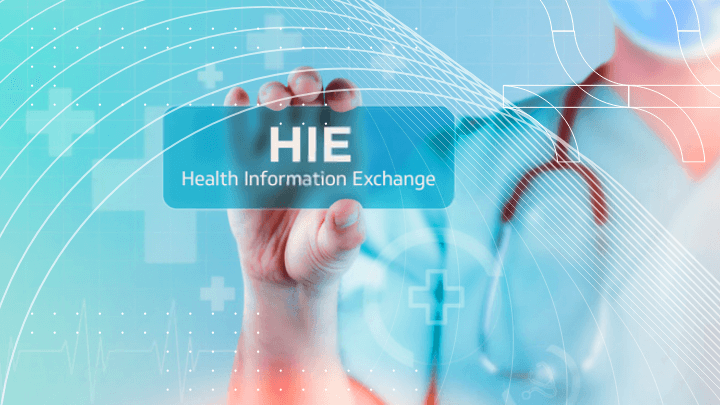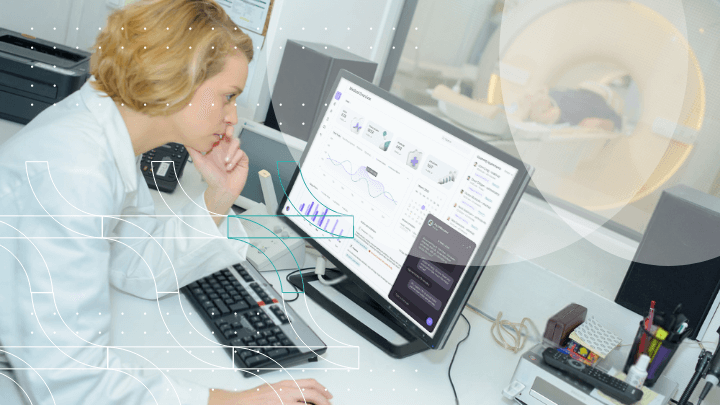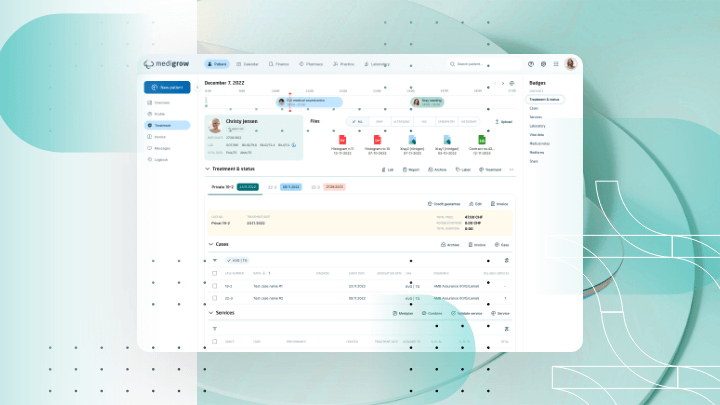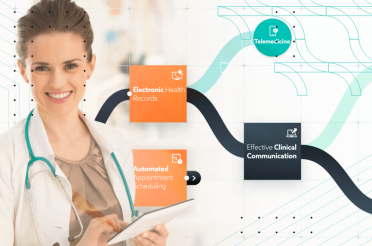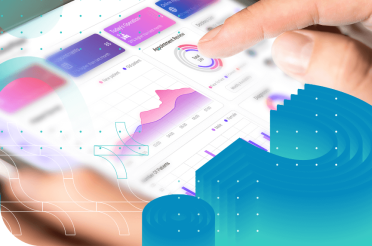Health information exchange (HIE) is an essential component in the healthcare sector, fundamentally concerned with the electronic movement of healthcare information across various organizations and systems.
The shift from traditional record-keeping to electronic health information exchange represents a monumental change in healthcare management.
Electronic HIE has revolutionized the process, allowing for the secure and swift transfer of patient information. More specifically, this has resulted in 94% of healthcare providers revealing that electronic HIE has made records readily available at the point of care.
Also, it has led to high patient satisfaction with more than 76% of patients finding it easier to obtain medications. Grasping the intricacies of how data transfer occurs is crucial for all industry stakeholders, and we will elucidate this process in this article.
Interoperability and data exchange in healthcare
Interoperability in healthcare IT refers to the ability of different systems, applications, and devices to exchange and effectively use electronic health data. This electronic exchange capability is crucial for optimizing health outcomes by enabling timely and secure access to health information.
Interoperability aims to reduce costs, improve quality, and enhance patient satisfaction in the healthcare domain.
Real-world examples highlight the progress and potential of interoperability in healthcare. Initiatives such as the Trusted Exchange Framework and Common Agreement (TEFCA) are setting the stage for universal interoperability standards. More specifically they are the main driver of the simplification of connectivity.
TEFCA led to the creation of a nationwide interoperability infrastructure for secure HIE. The Common Agreement, a part of TEFCA, is a legal contract that sets baseline legal and technical requirements that establish an infrastructure model for health information networks. (13) They ensure that technologies are developed with this goal in mind.
Through such initiatives, the healthcare industry is steadily moving towards a more interconnected and efficient system. In these systems, patient data is easily accessible and securely exchanged to enhance the quality of patient care.
Challenges in data exchange and interoperability
However, the journey towards achieving interoperability in healthcare faces several challenges:
- Technical barriers like system compatibility issues and the need for standardization of data formats.
- There’s also a need to address semantic barriers, which involve ensuring that the data exchanged between systems is interpretable and usable across different platforms.
- Organizational and legal barriers further complicate interoperability, especially in terms of policy and governance concerning data sharing and privacy.
A prime example of governance efforts to address these challenges is the European Health Data Space (EHDS), proposed by the European Commission. The EHDS aims to enhance individual control over personal health data. As a tool for overcoming legal barriers, it gives you the ability to access, manage, and share patient health data across national borders within the EU (10)
The EHDS framework supports the use of health data for improving healthcare delivery, healthcare research, innovation, and policy-making. This involves establishing common standards, practices, infrastructures, and a governance framework for secure data exchange and use.
Another mechanism for overcoming interoperability challenges includes the еlectronic exchange. By adopting modern standards like HL7’s Version 2. x (V2), HL7 Version 3 Clinical Document Architecture (CDA), and Fast Healthcare Interoperability Resources (FHIR), the healthcare industry can facilitate more effective and seamless data sharing.
The HL7 V2 is the most widespread standard whose backward compatibility has made it a go-to option in the healthcare industry. As a standard, it ensures efficient and standardized communication across different health IT systems. (14) The following version (V3) serves to ensure that the continuity and integrity of patient information are maintained across various healthcare settings.
On the other hand, FHIR FHIR emerged in the early 2010s as a newer standard, focusing on ease of implementation and modern web service technologies. Its main purpose is to break down information into smaller data chunks, which can represent various aspects of a patient’s healthcare data.
As a result, the adoption of FHIR is transforming healthcare data interactions, fostering innovation and more efficient clinical workflow.
HIE software: what to expect
On top of the above-mentioned mechanisms for overcoming interoperability challenges, the health information exchange (HIE) software plays a crucial role in patient data management and integration with electronic medical records (EMRs).
The essentials of HIE software are described below.
Medical data exchange and clinical data access
This feature ensures the effective exchange and access of medical and clinical data. It allows healthcare providers to review patient information promptly, which is essential for planning treatments and recovery strategies. Moreover, it facilitates care management strategies, empowering patients to make informed health decisions.
HIE software often includes functionalities that support interoperability, such as integrating healthcare enterprise (IHE) profiles and application programming interfaces (APIs), particularly FHIR APIs. These components are vital for ensuring data consistency and the secure exchange of health information between disparate systems.
Given that HIE involves sharing protected health information (ePHI), HIPAA compliance is a critical regulation. It ensures the protection of sensitive ePHI from cybersecurity threats and data breaches. Compliance with HIPAA safeguards (physical, administrative, and technical) is mandatory to avoid legal ramifications.

Discover how we can help outsource Healthcare projects efficiently
Speak to an expert today, and see how our on-demand IT talent and augmented teams can efficiently deliver value at every step of your roadmap.

Query-based, directed, and consumer-mediated exchanges
These forms of HIE cater to different needs. Query-based exchange is used in unplanned care situations, directed exchange for sending patient information securely between known and trusted healthcare professionals, and consumer-mediated exchange gives patients control over their health information.
Query-based exchange is a method in HIE where providers can find and pull information about a patient from other providers. This type of exchange is often used in situations where little is known about a patient or when new information is expected to be found in patient records. Therefore, by having access to comprehensive patient data, providers can avoid medication errors and unnecessary duplicate testing.
Directed exchange refers to the ability of a provider to send and receive secure health information electronically between other care providers to support coordinated care. As an exchange it improves by ensuring that all relevant patient information is readily available to all healthcare providers involved in a patient’s care.
Lastly, consumer-mediated exchange gives the majority of patients the ability to aggregate and manage their information on the Internet safely. It helps them transfer information between providers, correct inaccurate demographic, medical, or billing information, and track their health.
The perfect HIE software solution is… Custom made
When selecting the right health information exchange (HIE) software solution, there are several crucial factors you need to consider.
Firstly, you need to assess your current interoperability strategy and determine how it aligns with the HIE software you want to choose. Consider the systems you need to integrate and ensure the new software can accommodate these integrations.
Secondly, good HIE software should be able to grow and adapt to your organization’s changing needs. This includes handling increasing amounts of data and accommodating new functionalities as you continue to scale your healthcare services. This includes effectively engaging new customers by including an intuitive and user-friendly interface. A complicated or non-intuitive interface can hinder user adoption and efficiency.
Research is key in this process. Analyze user reviews and gather insights on real-world performance, reliability, and customer satisfaction of potential software partners. This feedback is invaluable in making an informed decision.
The level of support and training offered by your HIE software partner is another vital consideration. Effective implementation and ongoing system maintenance hinge on this support.
Before implementing health information exchange solutions, you need to be sure that it is compatible with your existing data structures and file types. If that’s not the case, your provider should be able to create custom configurations to meet your specific needs.

Deliver a world-class Healthcare project–with high-skilled, seamlessly integrated IT talent
Learn how from our consultants. We work with clients worldwide.
Take a look at HITECH
Now that you have chosen the perfect partner, you must understand how to legally follow all the needed standards and regulations to make it work for you correctly. The reason why you need to follow them is that they are crucial for maintaining the quality, safety, and efficiency of healthcare delivery.
The first act that you need to know about is the Health Information Technology for Economic and Clinical Health (HITECH) Act which authorized programs to improve healthcare through health IT and secure HIE. With this act, the national coordinator for HIE has gained an important role responsible for setting standards and certification criteria for Electronic Health Records (EHRs). This role aims to assure healthcare professionals that the systems they adopt are capable of performing certain functions.
The main impact of the HITECH Act is that it expanded the responsibilities of businesses associated with the HIPAA Security Rule. This ensured that everyone handling protected health information is accountable for maintaining the confidentiality, integrity, and availability of such information. Fortunately, with the right partner guiding you through the process, achieving compliance with HITECH can be a much more manageable task.
The best is yet to come
The HIE technology is set to undergo a transformative evolution, driven by emerging technologies and innovative exchange models. As we look toward the future, the incorporation of blockchain and artificial intelligence (AI) into HIE systems heralds a new era of enhanced security, efficiency, and personalized care.
Blockchain’s secure and transparent framework, coupled with AI’s prowess in handling complex data sets, promises to revolutionize patient data management, leading to more precise and effective healthcare solutions. The shift towards more dynamic centralized, federated, and hybrid models is poised to optimize data accessibility and security.
These advancements suggest a future where HIE technology not only improves healthcare interoperability and patient experience but also paves the way for a more connected, efficient, and patient-centric healthcare ecosystem.
As these technologies integrate seamlessly into HIE systems, the potential for transforming healthcare delivery is immense.
